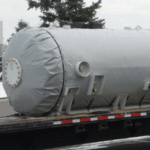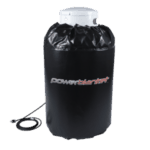Do you have an industrial process that requires container systems to maintain a constant temperature inside?
One option is to install an internal heating element. However, that is time-consuming, expensive, and impractical. It requires taking the tank offline, draining it, and cutting a hole in the side to install the heating element. Additionally, there will be eventual maintenance or replacement of the heating element, causing more downtime.
There is a simpler solution. It’s a heating jacket or heating blanket that can fit any size vessel, from 5-gallon pails to tanks that store thousands of gallons. Here is an overview of this economical and fast tank heating solution.
What Is a Tank Heating Jacket?
Don’t confuse a tank heating jacket with a steam jacketed tank. A jacketed tank has a second skin welded to the outside with a gap between the two walls. Pressurized steam, another heating or cooling liquid, will circulate in the gap creating a uniform heat transfer inside the vessel.
Tank heaters and tank warmers are flexible and portable solutions for heating single-walled tanks, totes, or drums of any size. A tank heating jacket fits snuggly around the tank providing even heat.
Why Do Industrial Tanks Freeze?
When industrial tanks freeze, it can delay a process and cost thousands of dollars. Here are some of the problems that heating jackets for tanks can avoid.
Liquids Freeze Easily
From wastewater to distilled water, tanks store every type of liquid. Water freezes at 32°F (0°C), but more viscous liquids like oils, waxes, honey, and other fluids have higher freezing temperatures. Maintaining the temperature inside the tank can be challenging when the surrounding environment may be well below freezing. Tank heaters and tank warmers are the solutions.
Flowing Gasses Freeze Valves and Regulators
Propane is one of the most used gasses for heating residential and industrial facilities. Occasionally, the regulator can freeze, preventing an adequate flow. If the tank is too full, the small headspace at the top of the tank doesn’t allow the gas to vaporize. Too little gas has the same effect as there is not adequate pressure.
Also, water vapor inside the tank can condense and freeze at the regulator. Warming the propane or other gas to higher temperatures can alleviate regulator freeze-ups.
Winter Weather Can Be Challenging
Winter is still a factor for industrial processes in the northern and southern hemispheres despite global warming claims. Most storage tanks are subject to ambient temperatures, affecting the viscosity and flow of whatever they’re holding. Depending on the product, temperatures don’t have to fall to 32°F (0°C) to slow or stall an industrial process.
Heaters for tanks are the best way to ensure viscosity and a steady gas or liquid flow. They can fit the tank and cover the regulator or valves to prevent freezing.
If freezing is a problem in the piping from the tank to the production line, install a heat trace system.
How Do Tank Heaters Work?
Our heating blankets begin with heating wires mounted on a graphite backing or printed on a flexible thin film. The heating section has closed-cell foam insulation on one side and a proprietary heat spreading material on the other, providing even heat across the entire surface. A durable chemical and tear-resistant shell protects the core on both sides.
Powerblanket heating jackets for tanks install quickly around any tank, vertical or horizontal, and connect with standard 120v or 240v power. Our tank heaters have optional programmable logic controllers to provide the exact temperature requirements needed for your process.
Industrial Heating Jackets Eliminate Tank Freezing Problems
Powerblanket can custom-build Propane tank heaters for up to 30,000-gallon bulk storage tanks, square or cylindrical. We can provide industrial heating jackets for any tank and fluid, including hazardous locations.
Powerblanket has industrial heating solutions for any industry, small or large.
Powerblanket's custom tank heaters provide freeze protection, making your business more sustainable and efficient.




